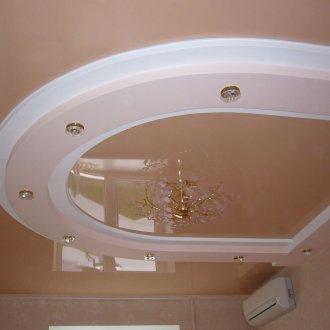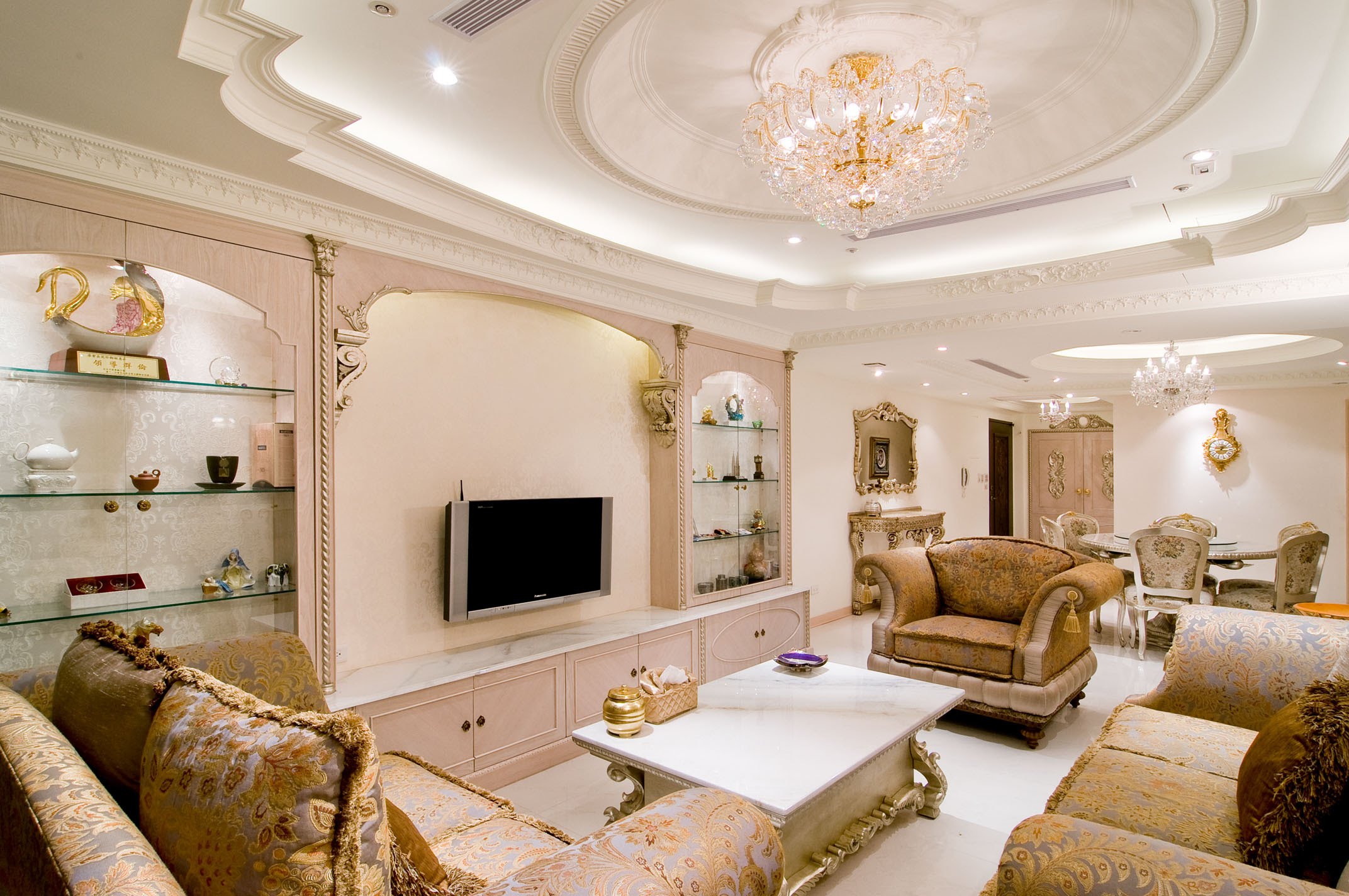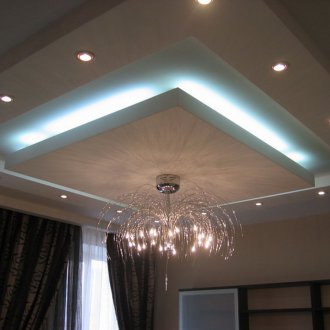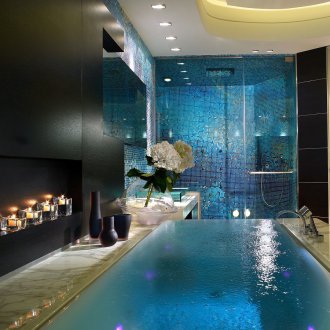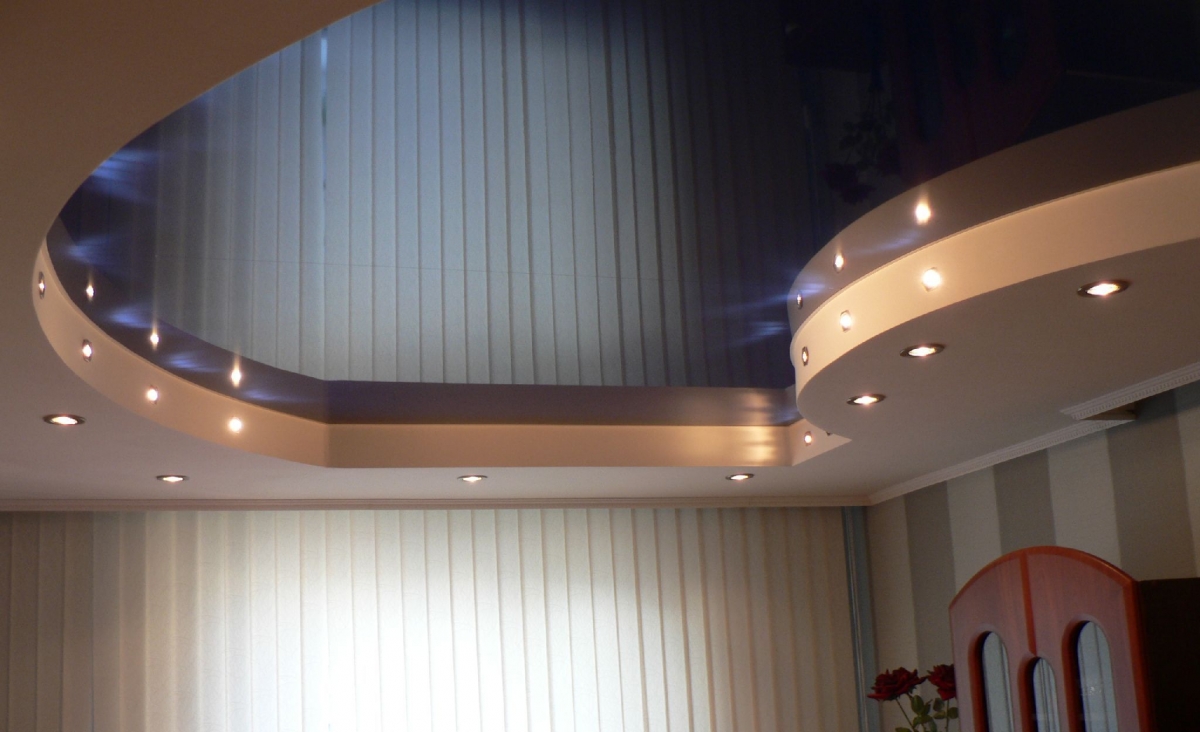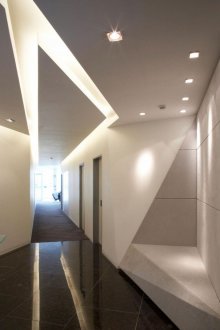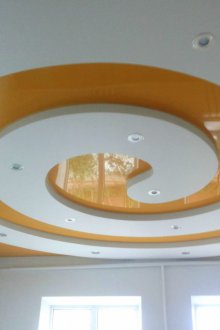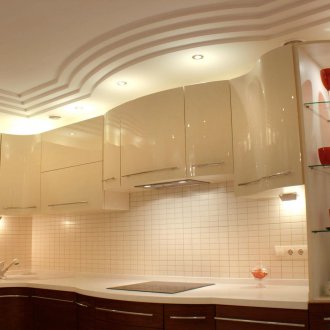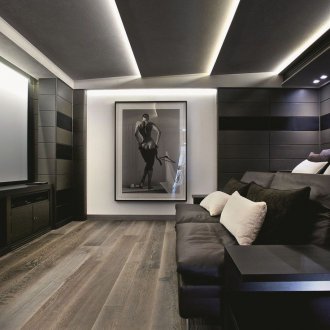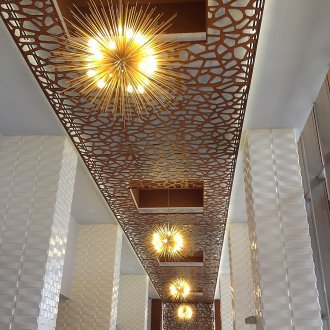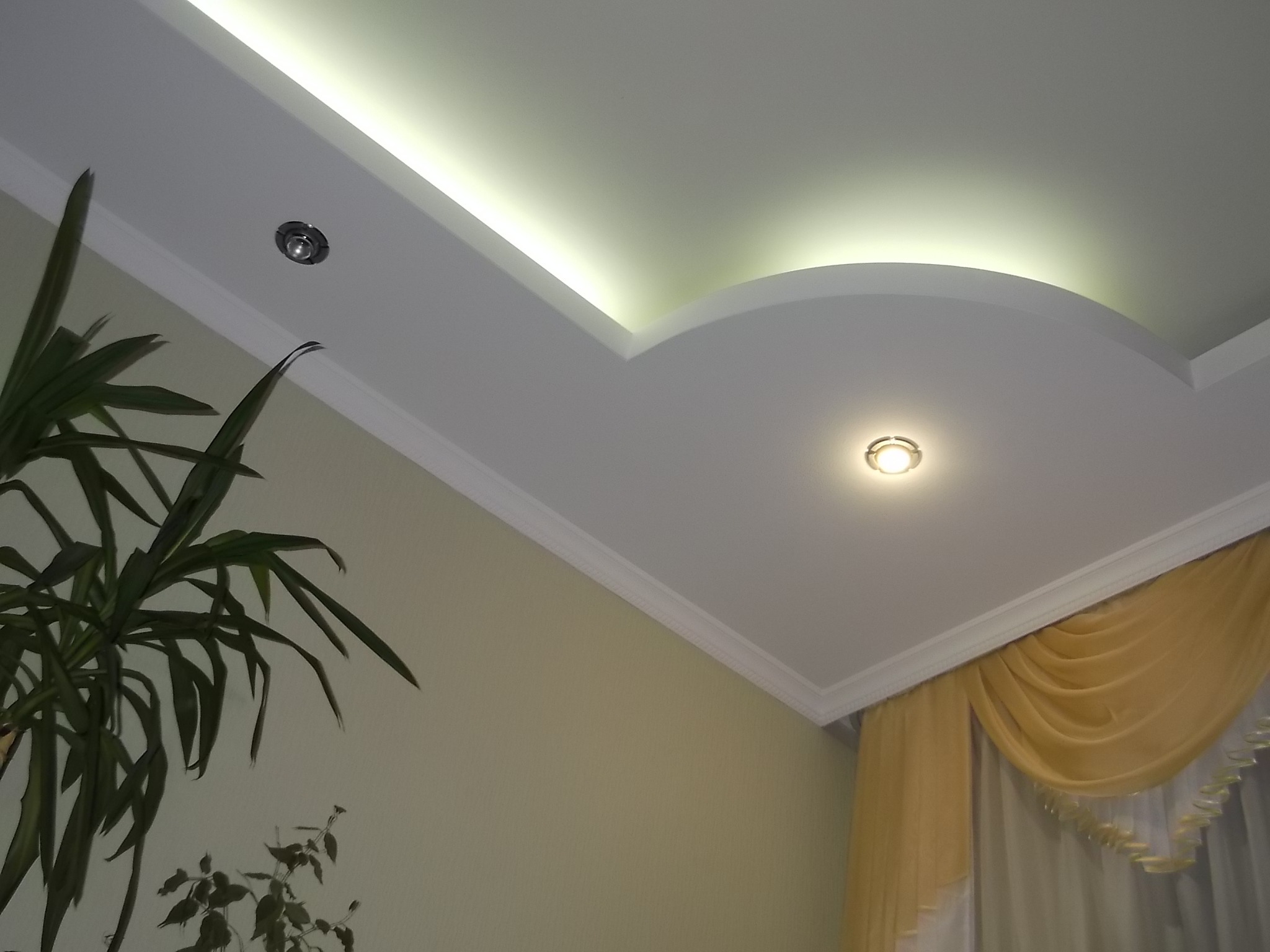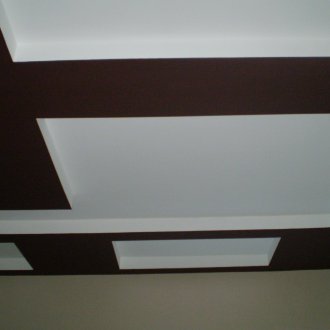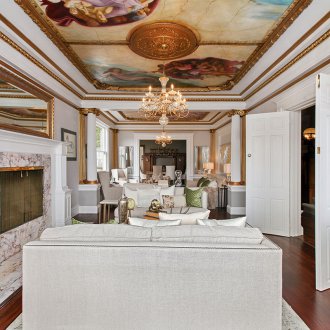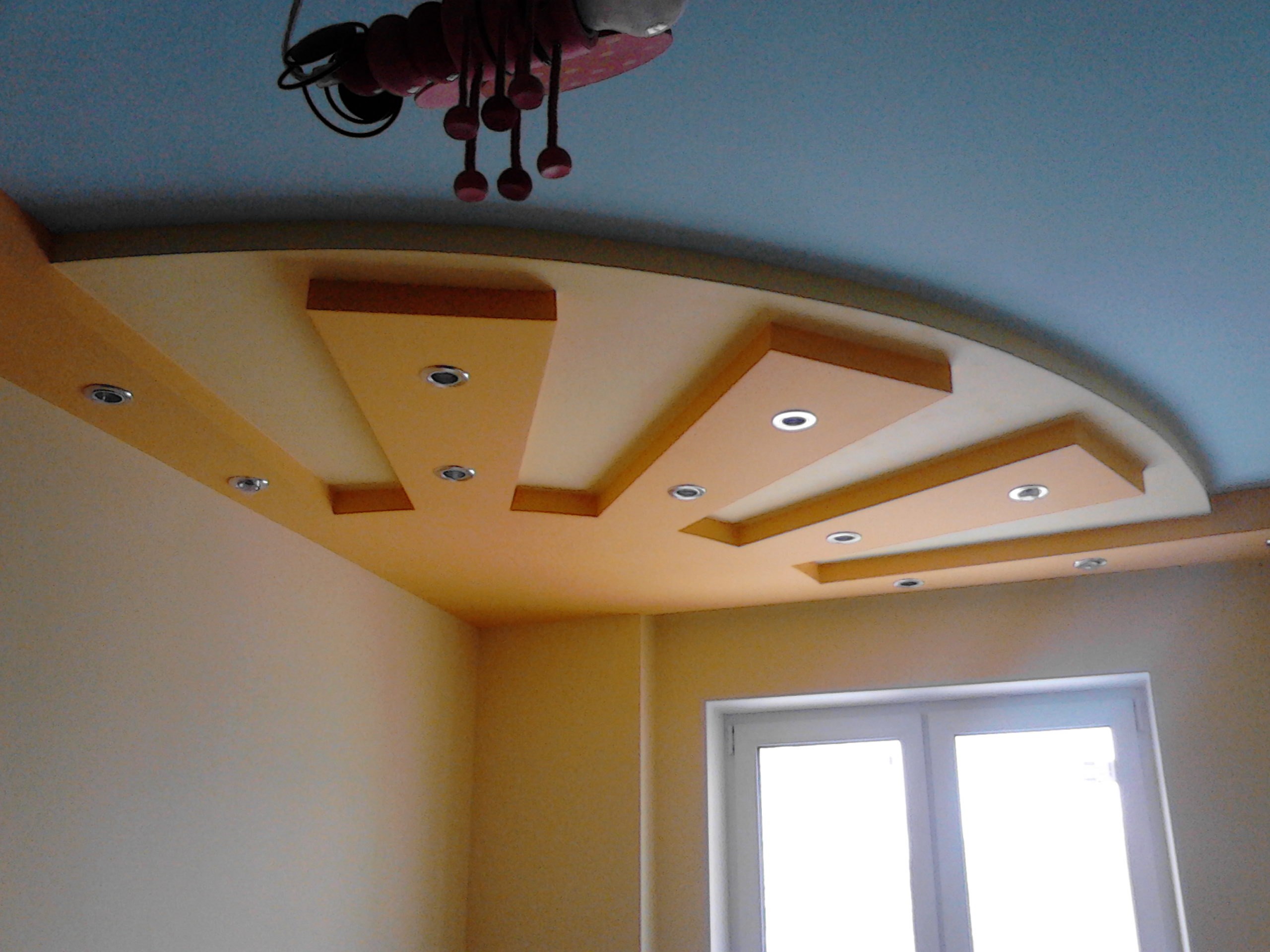Figured ceilings: specific types, their advantages, disadvantages and installation features (20 photos)
A properly executed ceiling can completely change the appearance of the room. Make it visually larger or smaller, give it a noble gloss or turn it into a very modern loft. Curly ceilings cope with such tasks better than others - it is much easier to express the designer’s intention with them, because voluminous structures always give more room for imagination than flat surfaces.
Types of figured ceilings
Depending on how much finances it is decided to invest in the installation of the ceiling, and on whether the foremen will be involved from the outside, the most suitable option is selected from the existing three:
- Foam shaped ceiling. The simplest and cheapest, artisanal option that can be easily done with your own hands at home. It does not require the manufacture of a special frame and the involvement of people from the outside - just a clerical knife, universal glue and good taste.
- Curly plasterboard ceilings. Also quite cheap, but more complex option. Drywall is heavier than polystyrene, therefore it requires a special framework on which subsequent layers will be layered. You can make it with your own hands, but it will require skill and experience - or at least time and materials for training.
- Curly stretch ceilings. The most expensive, the most complex, but at the same time looking more chic all option. It requires not only special skills, but also specialized equipment to stretch the canvas, it must first be heated. Also mounted on the frame.
If the design plan is complex and one material is not enough for its implementation, they can be combined. So, stretch ceilings are perfectly combined with plasterboard - their brilliant smoothness allows emphasizing plasterboard elements.
Moreover, all curly ceilings have common advantages. They are:
- aesthetic - with their help you can realize the most entertaining design decisions, while hiding cracks in the ceiling and unsightly communications;
- provide sound insulation - to varying degrees, depending on the material;
- help to influence the visual perception of the room - they can make it both larger and smaller;
- help to break the room into zones - the number and main characteristics vary according to the owner’s desire.
However, all curly ceilings somewhat conceal the ceiling height - up to a dozen centimeters in the case of suspended ceilings - and require some installation effort.
Each of the options has its own advantages, disadvantages and requires a special approach to installation.
Styrofoam Ceiling
Polyfoam is the cheapest material, but this is not its only advantage:
- Resistance to building mixes. The foam ceiling can be painted with water-based paints and varnished - this will not harm him.
- Resistant to water. Polyfoam does not suffer from high humidity, can not warp, go blistering or mold.
- Soundproofing. Of course, the soundproofing properties of the foam are imperfect, but they will help to somewhat muffle the sounds of the life of neighbors from above.
- Easy handling. Polyfoam is easy to cut with a simple clerical knife to your liking. It’s even easier to attach it to the ceiling - a universal glue is enough.
- Ease.Polyfoam does not require calculating whether the ceiling plate can support its weight.
- Diversity. You can buy polystyrene sheets of any size and shape.
- Lack of frame. The main advantage is that you do not need to fasten metal pipes that support the ceiling.
In addition to its advantages, it also has disadvantages:
- Combustibility Polyfoam light up quite easily, and, even worse, when burning emits suffocating black smoke.
- Resistant to water. This is a plus - but also a minus. The foam ceiling does not breathe, does not pass moisture into the room and does not let it out of it. As a result, air humidity increases.
- Relative fragility. Polyfoam is not very resistant to mechanical damage, so you need to work with it carefully.
- Cheapness. This is a plus, but also a minus. Styrofoam will look out of place in an expensive interior, will not fit into the classic style and generally suits a limited number of interiors.
However, if in a particular situation the pros outweigh the cons, polystyrene can be a great solution for a bedroom, a living room, a kitchen or a corridor. Installation takes place sequentially:
- Thinking over the plan. On a sheet of paper you need to draw a sketch of how the ceiling will look in the end. Calculate what size each part should be.
- Cutting parts. Cutting on polystyrene is simple - you can use a jigsaw for thick sheets and an office knife for thin ones. The result should be finished parts that are ideally suited to each other and corresponding to the sketch.
- Ceiling preparation. The ceiling is cleaned of old plaster, dirt and dust are removed from it. After that, it is plastered again and covered with a primer in two layers.
- Polyfoam installation. Foam elements are light - it is enough to coat them with universal glue and firmly press them to the ceiling for a short time.
- Finish. A layer of gypsum plaster is applied to the foam layer. After it dries, the surface is primed in two layers and sanded.
- Painting. The finished ceiling is painted - in bright warm colors in the kitchen, muted in the corridor - and when it dries, it is considered ready.
The process will take some time, because the ceiling elements need time to dry. However, the result will be worth it - in addition, it will take less time than other options for the figured ceiling.
Plasterboard ceiling
Drywall is plastic, but this is not its only advantage:
- Aesthetics. Drywall allows you to hide all the imperfections of the ceiling - if the stove in the kitchen or in the corridor is cracked or ugly, the curved GKL ceiling will help to hide it.
- Soundproofing. Hyposkarton is better than polystyrene. Of course, it will not help 100% get rid of annoying sounds, but it will help to make them quieter.
- Environmental friendliness. There is nothing in the composition of drywall that could harm the environment.
- Inability to burn. In case of fire, drywall will not burn.
- Reliability. Drywall can last for many years and it does not need to be updated time after time - just follow the general condition just in case.
- Convenience of installation of fixtures. Plasterboard sheets are easily adjusted to the desired shape, easily drilled. To make a curly ceiling with backlighting using them is very simple.
In addition to the pros, there are also disadvantages:
- Lack of resistance to water. Drywall can warp, go in waves, damp and even begin to rot if the room is wet.
- Lack of resistance to natural hazards. Drywall can become moldy, can become a refuge for rodents or cockroaches.
- Relative fragility. Work with drywall sheets carefully.
Drywall installation is a long and laborious process, which can still be carried out at home - in the kitchen, in the corridor, in the bedroom. It passes sequentially.
- Ceiling preparation. The surface is cleaned, all cracks and cracks are closed.
- Planning. Passes in several stages:
- the room is measured as accurately as possible and transferred to paper on a convenient scale;
- the whole plan is divided into small squares of 60 by 60 cm on a convenient scale;
- colored pencils indicate the borders of different levels of the future figured ceiling;
- pencils of a different color indicate the points at which the ceiling will rest on the frame;
- the position of the fixtures and wires leading to them is marked.
- Markup. The plan is transferred to the ceiling - as accurately as possible, the points where the frame will be attached and the boundaries of the levels pass should be marked.
- Production and installation of the frame. It is made from a metal profile with the help of screws and a drill.
- Installation of drywall sheets. First you need to adjust them so that the figured ceiling is folded out of them, like a mosaic of individual parts.
- Finish. The finished ceiling must be puttied and, if necessary, painted.
Working on a plasterboard ceiling is harder than working on a foam ceiling, but the result will be more impressive and durable.
Stretch ceiling
Curly suspended ceilings that can be installed in the kitchen, in the corridor, in the bedroom or even in the bathroom, there are two main types:
- Film. Glossy, with a gloss.
- Fabric. Soft, which look like stretched fabric. Always matte.
The main characteristics, however, practically do not differ, as well as the main advantages:
- Long service life. If you do not damage the ceiling mechanically, it will last for many years.
- Safety and environmental friendliness. Stretch ceilings are completely harmless to human health and do not emit any toxins that could affect the environment.
- Resistant to water. Stretch ceilings are insensitive to moisture, cannot mold and will not rot.
- Ease of care. It is enough to wipe a figured stretch ceiling sometimes with a cloth so that it remains as bright as in the first days.
- Huge selection of colors. With the help of a stretch ceiling you can realize any fantasy.
There are also disadvantages:
- The stretch ceiling is easily damaged mechanically.
- Stretch ceilings give off a faint smell of rubber.
- Stretch ceilings, even simple ones, cannot be mounted on their own - there is no question of curly ceilings.
However, it is the stretch ceiling that will look the most chic, especially if it is reasonable to combine it with elements from drywall. However, for each option there is a suitable situation and design in which this particular ceiling will look most appropriate.
